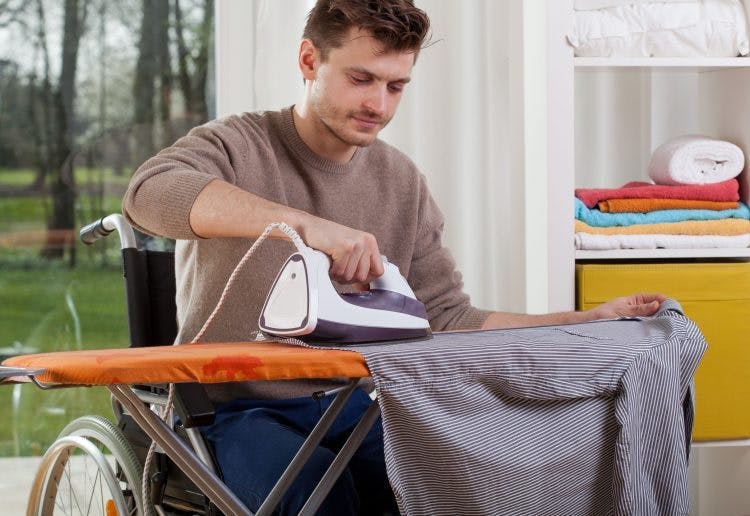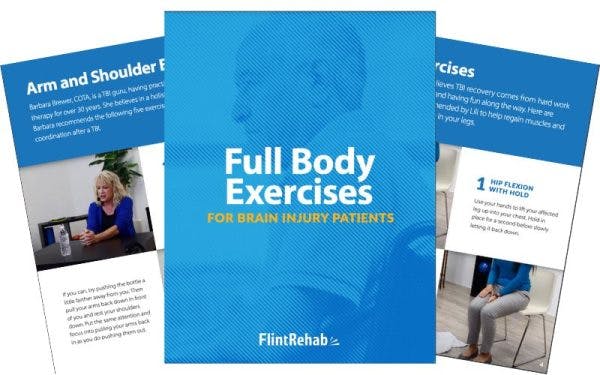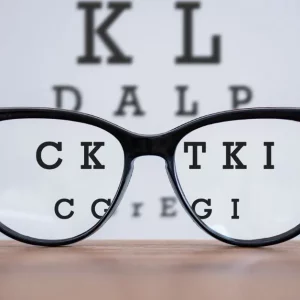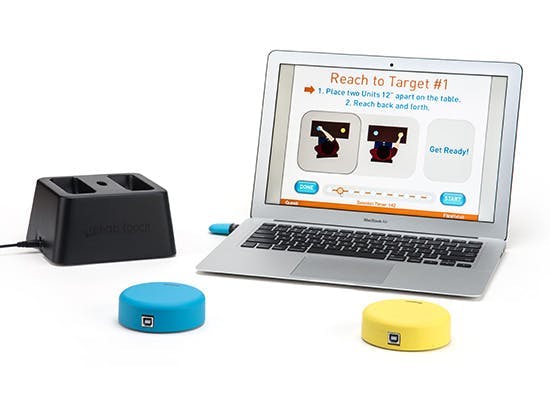Occupational therapy is a rehabilitative discipline focused on helping individuals perform their valued daily activities, which can be referred to as occupations. Since a traumatic brain injury (TBI) can significantly impact the ability to perform one’s daily occupations, many TBI survivors are recommended to pursue occupational therapy.
There are an endless number of TBI occupational therapy activities that can be used to help survivors improve their independence after brain injury. While practicing these activities during occupational therapy sessions can initiate the recovery process, survivors often begin to see greater improvements when practicing at home on a consistent basis.
This article includes an outline of seven different TBI occupational therapy activities focused on improving various secondary effects of brain injury. The mechanism by which these activities stimulate recovery is also discussed.
Please use the links below to jump directly to any section of this article:
- How can OT activities promote recovery?
- Physical activities
- Cognitive activities
- Emotional/behavioral activities
The Importance of TBI Occupational Therapy Activities
A traumatic brain injury can result in various physical, cognitive and psychological changes. These effects of TBI may impact the ability to perform self-care tasks, participate in home management activities, complete job duties, and/or pursue leisure pursuits.
Participating in TBI occupational therapy activities can help survivors recover by retraining the brain to restore these functions. Repetitive practice of tasks involving affected functions stimulates an adaptive rewiring process called neuroplasticity within the brain.
Through neuroplasticity, the brain is able to create and strengthen neural pathways to perform a specific skill. These pathways can allow healthy areas of the brain to assume control over functions that were housed in the damaged areas. With consistent practice, these new neural pathways become stronger, and the ability to perform affected functions improves.
This is why it is important to practice TBI occupational therapy activities both during OT sessions and at home. Consistently stimulating the brain is the best way to achieve an optimal recovery.
Want 25 pages of TBI recovery exercises in PDF form? Click here to download our free TBI Rehab Exercise ebook now (link opens a pop up for uninterrupted reading)
TBI Occupational Therapy Activities Addressing Physical Skills
There are a number of physical functions that may be affected by a traumatic brain injury, including muscle strength, fine motor skills, balance, and mobility. Furthermore, many survivors also experience difficulties with motor planning, referred to as apraxia. This can also affect the ability to physically perform tasks effectively.
There are many TBI occupational therapy activities that can address physical deficits and motor planning, including:
1. Dressing
This TBI occupational therapy activity may seem straightforward. However, the process of dressing oneself requires many different physical functions.
Through dressing, survivors can practice their mobility and balance while walking to the closet to retrieve clothes. Gross and fine motor coordination can be challenged by putting the arms and legs into clothing and completing fasteners.
Dressing can also address a type of motor planning skill called ideational praxis, which involves “manipulat[ing] objects in a sequence of actions involving knowledge of object function, knowledge of action and serial order.” Stated simply, dressing requires individuals to plan the parts of the body that each item of clothing goes on and the order in which to put them on.
For individuals who struggle with the physical components of dressing, occupational therapists may suggest using adaptive equipment or compensatory strategies, such using a reacher or dressing the affected extremities first. Practicing the process of dressing daily can help survivors improve both their independence and motor skills.
2. Playing Games
Playing board games, card games and video games can be an engaging and effective way to enhance fine motor skills. Each of these types of games involves manipulating small objects, requiring a great amount of fine motor coordination.
Playing relatively fast-paced games that require a quick reaction time can also help individuals with their motor planning skills. In addition to improving motor functions, playing games can also help with restoring cognitive skills such as decision making, visual scanning, and problem-solving.
Gamified rehabilitation devices, such as the Music Glove and FitMi, can also be used as TBI occupational therapy activities. The Music Glove addresses fine motor functions through moving the fingers to the beat of music, while the FitMi can adapt to an individual’s skill level to address physical functions throughout the body. Whether games are designed specifically for therapy or not, they can be excellent tools to use to help promote recovery.
TBI Occupational Therapy Activities for Cognitive Skills
Cognition may also be affected following a TBI, especially if the injury occurs in the frontal lobe. This is because the frontal lobe plays a significant role in many higher-level cognitive skills, including executive functions, attention, memory, organization, and language.
Some TBI occupational therapy activities focused on improving cognitive skills include:
3. Cooking
Cooking is one of the best TBI occupational therapy activities. This is because it targets a practical skill while addressing numerous cognitive and physical functions. Cooking from a recipe requires the ability to read, sequencing and organization skills, and intact judgement and problem-solving abilities.
For individuals with moderate cognitive deficits who have not yet tried to cook following their TBI, it is often best to start with a simple recipe with limited steps, such as making a sandwich. Survivors who are looking for a challenge can practice making a recipe with multiple components, such as pasta with a homemade sauce. However, for survivors lacking sensation, judgment skills, or safety awareness, always use caution and/or provide supervision if using the oven, stove, or microwave.
4. Sketching from Memory
Sketching an image from memory targets many cognitive skills, including attention, memory, insight and perception. Start by looking at a picture or scene for one minute. Then, without looking at it, attempt to draw the image. If drawing is too difficult, make a list of everything that was included in the scene (for example, two dogs, a taxi, a bicycle, etc..). Finally, compare the drawing to the original, examining the similarities and differences.
If this is too challenging, try starting with a very simple drawing with only one main picture, then gradually increase the difficulty. To make this TBI occupational therapy activity more challenging, try replicating a complex picture, setting a time limit, or taking a short break before attempting to draw the image.
5. Cognitive Training Apps
While TBI occupational therapy activities focused on cognition can be integrated into one’s daily activities, some individuals prefer to have a specified practice technique. Cognitive training apps can give these survivors the structured practice they desire and provide a concrete way to track progress.
For example, the CT Speech and Cognitive Therapy App contains thousands of exercises that can help individuals improve language, memory and concentration skills. The app allows survivors choose specific skills they’d like to focus on, and is able to provide exercises at an optimally challenging level for the survivor’s abilities. While cognitive training apps are great resources, it is also essential to practice carrying over the skills learned using these apps to daily activities.
Traumatic Brain Injury Occupational Therapy Activities for Emotional Wellness
Sustaining a traumatic brain injury can be a psychologically challenging experience. While emotional and behavioral changes may occur due to the location of injury, survivors may also experience emotional challenges as they adapt to their lives after brain injury and pursue recovery.
Emotional and behavioral effects of brain injury include depression, impulsivity, personality changes, and aggression. These effects can impact survivors’ ability to participate in daily activities and their motivation to pursue recovery.
A few TBI occupational therapy activities to address behavioral challenges and emotional wellness include:
6. Yoga
Practicing yoga has many benefits for TBI survivors, including improving emotional regulation and the mind-body connection. Yoga can be adapted to any physical or psychological skill level, allowing individuals to practice at a level appropriate for their abilities.
While yoga can be practiced individually, participating in a therapeutic group yoga program can give TBI survivors the opportunity to enhance their social and community integration skills. Studies have also shown that stress, impulsivity, and anger among survivors can improve through this TBI occupational therapy activity, making yoga an effective way to improve survivors’ wellbeing.
7. Practicing Mindfulness
Mindfulness involves being present in the moment through awareness of one’s body and surrounding environment. Since many survivors have difficulties with sustained attention, they may choose to use a guided mindfulness program before progressing to practicing independently. These are readily available through online videos, apps, and smart watches, many of which provide daily reminders to practice.
One way to practice mindfulness is to sit with the eyes closed and focus on the breath. Next, consider how the body is feeling, both physically and emotionally. Try not to let the thoughts run wild, but instead think just of the current moment in time. Start by practicing this for a few minutes each day, gradually increasing the duration of practice as appropriate.
Practicing mindfulness has a number of benefits, including improving depression, stress, and fatigue. Mindfulness can be practiced just about anywhere for any amount of time, making it one of the most versatile TBI occupational therapy activities to improve emotional wellness.
Although each TBI occupational therapy activity above targets a specific type of skill, many of these activities can be adapted to address a number of physical, cognitive, and/or emotional functions. Working with an occupational therapist can help survivors learn how to adapt these activities and discover more personalized TBI occupational therapy activities to promote recovery.
Understanding Traumatic Brain Injury Occupational Therapy Activities
Occupational therapy is a rehabilitative discipline focused on improving the ability to participate in valued daily activities. By practicing TBI occupational therapy activities, survivors can improve their physical, cognitive, and emotional skills.
Consistent practice is essential for promoting improvements through neuroplasticity, the brain’s process of adaptive rewiring. Each of the TBI occupational therapy activities included above can be practiced in both a clinical or home setting. Thus, these activities can be an excellent starting point for individuals to begin consistently practicing their functional skills for daily life.










